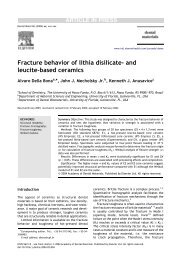Microtensile bond strength of a filled vs unfilled adhesive to dentin ...
Microtensile bond strength of a filled vs unfilled adhesive to dentin ...
Microtensile bond strength of a filled vs unfilled adhesive to dentin ...
You also want an ePaper? Increase the reach of your titles
YUMPU automatically turns print PDFs into web optimized ePapers that Google loves.
288<br />
Figure 4 (A) Scanning electron micrograph <strong>of</strong> the resin–<br />
<strong>dentin</strong> interface <strong>bond</strong>ed with One-Step with self-etch<br />
technique after argon ion etching. Thickness <strong>of</strong> the hybrid<br />
layer (3.5 mm) was similar <strong>to</strong> the One-Step <strong>to</strong>tal-etch<br />
group (Fig. 3(A) and (B)). The un<strong>filled</strong> <strong>adhesive</strong> layer was<br />
only 2 mm thick (compare Fig. 2(A) and (B)). c, composite;<br />
a, <strong>adhesive</strong>; h, hybrid layer; d, <strong>dentin</strong>. (B) Scanning<br />
electron micrograph <strong>of</strong> the resin–<strong>dentin</strong> interface <strong>bond</strong>ed<br />
with One-Step with self-etch technique subjected <strong>to</strong><br />
sequential acid–base treatment. Thickness <strong>of</strong> the hybrid<br />
layer (3.5 mm) was similar <strong>to</strong> the One-Step <strong>to</strong>tal-etch<br />
group (Fig. 3(A) and (B)). c, composite; a, <strong>adhesive</strong>; h,<br />
hybrid layer; d, <strong>dentin</strong>, g, gap induced in the <strong>adhesive</strong><br />
layer and between hybrid layer and <strong>adhesive</strong> layer.<br />
<strong>adhesive</strong> failures (Fig. 6). Using <strong>to</strong>tal-etch technique,<br />
the <strong>filled</strong> <strong>adhesive</strong> One-Step Plus (Fig. 5)<br />
and un<strong>filled</strong> <strong>adhesive</strong> One-Step (Fig. 7) showed<br />
mostly mixed failures.<br />
Discussion<br />
E. Can Say et al.<br />
Filled <strong>adhesive</strong>s were expected <strong>to</strong> act as an<br />
intermediate shock-absorbing elastic layer<br />
between composite resin and <strong>dentin</strong>, thus increasing<br />
the <strong>bond</strong> <strong>strength</strong> <strong>to</strong> <strong>dentin</strong>. 1,3,20 Many studies<br />
evaluated comparisons between commercially<br />
available <strong>filled</strong> and un<strong>filled</strong> <strong>adhesive</strong>s however,<br />
the advantages <strong>of</strong> these <strong>adhesive</strong>s as stress buffers<br />
remain unpredictable 7 and have not been substantiated<br />
with in vitro <strong>bond</strong> tests 25–29 and a clinical<br />
trial. 30 Filler type, size, shape, its surface characteristics,<br />
their interaction with the resin matrix and<br />
various solvents in the <strong>adhesive</strong>s may affect the<br />
<strong>bond</strong> <strong>strength</strong>. 20,21,31–33 The un<strong>filled</strong> <strong>adhesive</strong> One-<br />
Step and <strong>filled</strong> <strong>adhesive</strong> One-Step Plus, used in this<br />
study, utilizes ace<strong>to</strong>ne as a solvent. Besides, One-<br />
Step Plus consists <strong>of</strong> 8.5% Glass fillers with an<br />
average particle size <strong>of</strong> 1 mm. SEM observations <strong>of</strong><br />
the resin-<strong>dentin</strong> interfaces revealed that the<br />
thickness <strong>of</strong> the hybrid layer created with One-<br />
Step Plus was almost similar <strong>to</strong> that achieved with<br />
One-Step both with <strong>to</strong>tal-etch (approximately<br />
3 mm; Figs. 1(B) and 3(B), respectively) and selfetch<br />
(approximately 3.5 mm; Figs. 2(B) and 4(B))<br />
techniques. Conversely, the <strong>adhesive</strong> layer <strong>of</strong> the<br />
<strong>filled</strong> <strong>adhesive</strong> was thicker (Figs. 1(A) and (B), 2(A)<br />
and (B)) than the un<strong>filled</strong> <strong>adhesive</strong> (Fig. 3(A) and<br />
(B), 4(A)). Filler particles were found around the<br />
tubular orifices and in some <strong>dentin</strong> tubules<br />
(Fig. 1(A)) with the <strong>to</strong>tal-etch technique, however<br />
they were not capable <strong>of</strong> penetrating in<strong>to</strong> the<br />
spaces between collagen fibers because the width<br />
<strong>of</strong> interfibrillar spaces is about 20 nm. 9 The results<br />
<strong>of</strong> the microtensile <strong>bond</strong> test showed that <strong>bond</strong><br />
<strong>strength</strong>s <strong>to</strong> <strong>dentin</strong> between <strong>filled</strong> <strong>adhesive</strong> One-<br />
Step Plus and the un<strong>filled</strong> <strong>adhesive</strong> One-Step were<br />
not significantly different when they were used with<br />
the <strong>to</strong>tal etch (38.8G12.2 and 33.9G8.5 MPa,<br />
respectively) and with the self-etch technique<br />
(22.4G4.0 and 26.4G7.5 MPa, respectively).<br />
These results might indicate that the penetration<br />
ability <strong>of</strong> the resin monomer and the evaporation<br />
rate <strong>of</strong> water/solvent from <strong>dentin</strong> subsurface are<br />
not so different between <strong>filled</strong> and un<strong>filled</strong><br />
Table 4 Failure modes <strong>of</strong> the specimens after microtensile <strong>bond</strong> test.<br />
Groups Adhesive Mixed Cohesive in <strong>dentin</strong> Cohesive in composite<br />
One-Step Plus <strong>to</strong>tal-etch 3 15 2 –<br />
One-Step Plus self-etch 17 3 – –<br />
One-Step <strong>to</strong>tal-etch 5 15 – –<br />
One-Step self-etch 14 6 – –<br />
Adhesive, between resin and <strong>dentin</strong>; Mixed, partially <strong>adhesive</strong>, partially cohesive failure in <strong>bond</strong>ing resin or hybrid layer; Cohesive in<br />
<strong>dentin</strong>; Cohesive in resin.
















